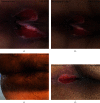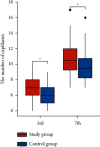The Effects of Phellodendron Decoction on Wound Healing of Anal Fistula after Anal Fistulotomy
- PMID: 36016687
- PMCID: PMC9396417
- DOI: 10.1155/2022/7363006
The Effects of Phellodendron Decoction on Wound Healing of Anal Fistula after Anal Fistulotomy
Abstract
Objective: To analyze the therapeutic effect of Compound Phellodendron decoction on wounds after anal fistulotomy.
Methods: 100 patients with anal fistula who underwent anal fistulotomy from April 2019 to April 2021 were included in the study group and control group according to the random number table method. 50 patients in the study group were treated with Compound Phellodendron decoction by fumigation and sitting bath, while warm water replaced Compound Phellodendron decoction in the control group. Perianal pain, wound edema, and exudation were scored on postoperative days 3 and 7, and wound healing time was recorded. Interleukin-2(IL-2), IL-5, IL-6, and IL-12 were measured via a double-antibody sandwich enzyme-linked immunosorbent assay. Hematoxylin-eosin (HE) staining and immunofluorescence were used to quantitatively analyze the capillary number and CD4+ and CD8+ lymphocytes in granulation tissue on postoperative days 7.
Results: The scores of pain, edema, and exudation in 2 groups on postoperative day 7 were lower than those on the 3rd postoperative day. Compared with the control group, the pain, edema, and exudation scores in the study group were decreased, and the wound healing time was shortened; the expressions of IL-2 and IL-12 in the study group were significantly increased, while the expressions of IL-5 and IL-6 were decreased; the number of capillaries and CD4+ lymphocytes in the study group was increased, while the number of CD8+ lymphocytes was decreased.
Conclusion: Compound Phellodendron decoction had efficacy in promoting wound healing, reducing complications, and changing lymphocyte aggregation and alleviating local inflammatory response.
Copyright © 2022 Heng Deng et al.
Conflict of interest statement
The authors declare that there are no conflicts of interest.
Figures







Similar articles
-
Study on the effect and mechanism of Yanghe decoction Huacai on tissue repair ofsyndrome after anal fistula surgery.J Tradit Chin Med. 2024 Aug;44(4):813-721. doi: 10.19852/j.cnki.jtcm.20240515.004. J Tradit Chin Med. 2024. PMID: 39066542 Free PMC article. Clinical Trial.
-
Evaluation of the Effectiveness of a Combination of Chinese Herbal Fumigation Sitz-Bath and Red Ointment in Managing Postoperative Wound Healing and Pain Control in Anal Fistula Patients.Contrast Media Mol Imaging. 2022 Sep 15;2022:1905279. doi: 10.1155/2022/1905279. eCollection 2022. Contrast Media Mol Imaging. 2022. Retraction in: Contrast Media Mol Imaging. 2023 Aug 2;2023:9767098. doi: 10.1155/2023/9767098. PMID: 36176927 Free PMC article. Retracted. Clinical Trial.
-
Fistulotomy with or without marsupialisation of wound edges in treatment of simple anal fistula: a randomised controlled trial.Ann R Coll Surg Engl. 2019 Sep;101(7):472-478. doi: 10.1308/rcsann.2019.0057. Epub 2019 Jun 3. Ann R Coll Surg Engl. 2019. PMID: 31155896 Free PMC article. Clinical Trial.
-
A randomized controlled trial on the effect of topical phenytoin 2% on wound healing after anal fistulotomy.Colorectal Dis. 2019 Jun;21(6):697-704. doi: 10.1111/codi.14580. Epub 2019 Mar 4. Colorectal Dis. 2019. PMID: 30740877 Clinical Trial.
-
Famous traditional Mongolian medicine Xieriga-4 (Turmeric-4) decoction: A review.Chin Herb Med. 2022 Jul 12;14(3):385-391. doi: 10.1016/j.chmed.2022.05.002. eCollection 2022 Jul. Chin Herb Med. 2022. PMID: 36118011 Free PMC article. Review.
Cited by
-
Evaluation of the mechanical properties and clinical application of nickel-titanium shape memory alloy anal fistula clip.Front Surg. 2023 Aug 23;10:1235666. doi: 10.3389/fsurg.2023.1235666. eCollection 2023. Front Surg. 2023. PMID: 37680263 Free PMC article.
-
Research progress on the application of Chinese herbal medicine in anal fistula surgery.Am J Transl Res. 2024 Aug 15;16(8):3519-3533. doi: 10.62347/DZHK5180. eCollection 2024. Am J Transl Res. 2024. PMID: 39262715 Free PMC article. Review.
-
Internal Orifice Alloy Closure: A New Procedure for Treatment of Perianal Fistulizing Crohn's Disease.Med Sci Monit. 2023 Jul 12;29:e940873. doi: 10.12659/MSM.940873. Med Sci Monit. 2023. PMID: 37434329 Free PMC article.
-
Mechanisms of Huhuang decoction in treating diabetic wounds: a network pharmacological and experimental study.Int J Med Sci. 2025 Mar 10;22(8):1811-1824. doi: 10.7150/ijms.108187. eCollection 2025. Int J Med Sci. 2025. PMID: 40225864 Free PMC article.
-
Effect of Neibu Huangqi Youhua formula on postoperative wound healing, inflammatory factors and pain mediators of anal fistula.J Tradit Chin Med. 2025 Jun;45(3):628-632. doi: 10.19852/j.cnki.jtcm.2025.03.015. J Tradit Chin Med. 2025. PMID: 40524301 Free PMC article. Clinical Trial.
References
LinkOut - more resources
Full Text Sources
Research Materials
Miscellaneous

